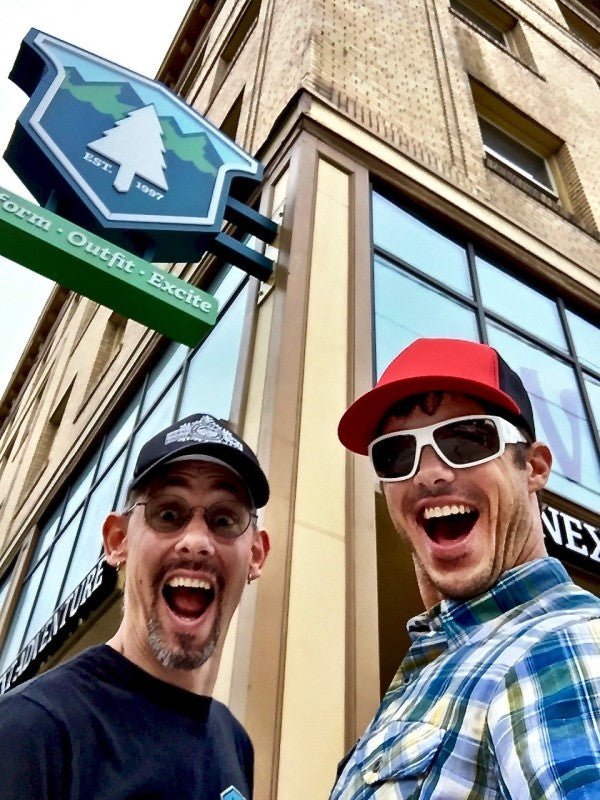
Ski Tuning 101 w/ Greg Coulter
Winter is finally here!!! That means several things, incessantly looking at the snow report, checking out all that sweet new gear that's coming out and the annual pilgrimage to the ski shop to get your skis and boards tuned!!! Although it isn’t rocket science, ski and board tuning is often misunderstood and confusing. Waxing, hot boxing, scraping, shaping, mounting… Are we at a ski shop or a beauty salon!?
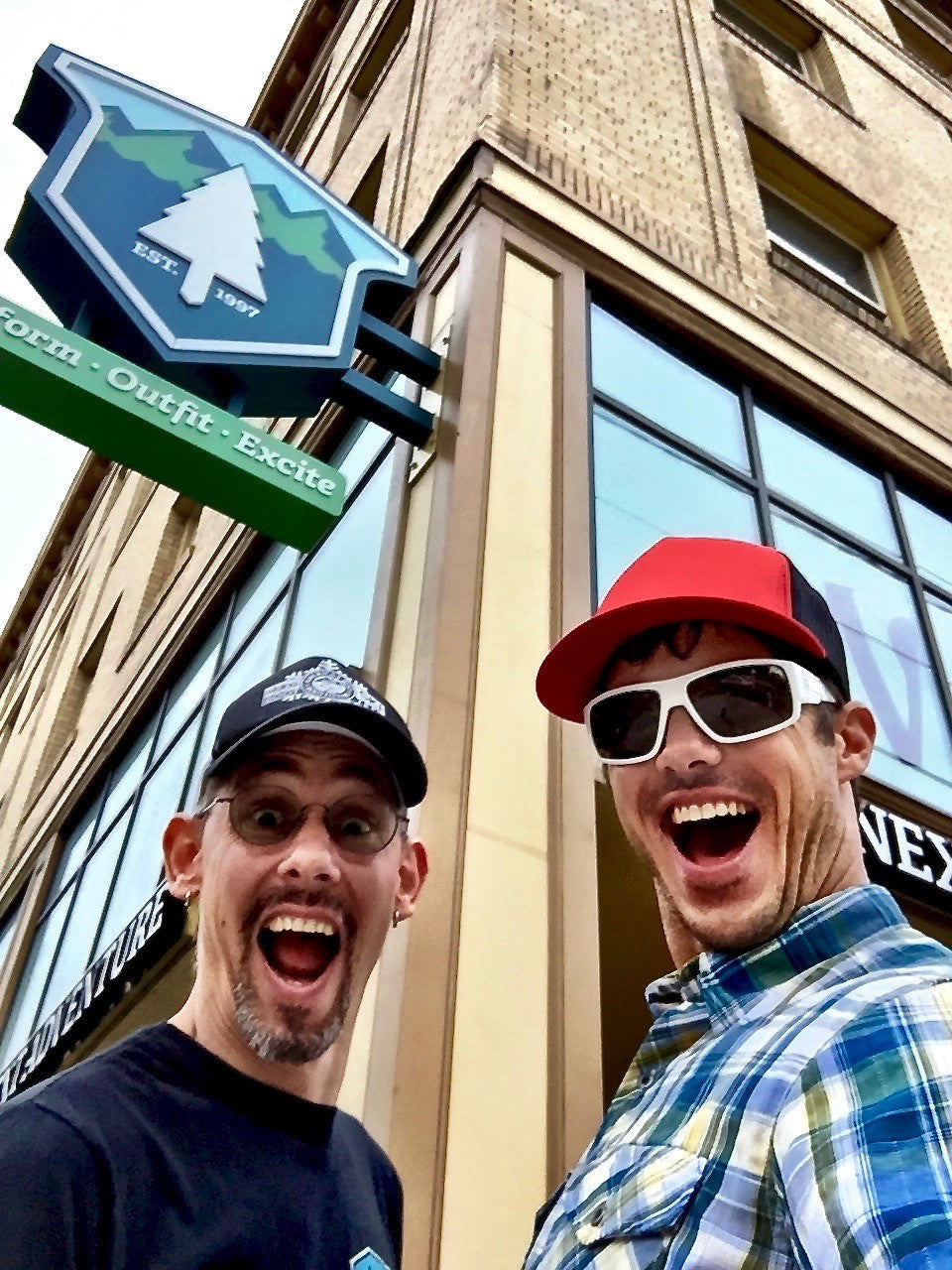 I did like I always do and headed to my favorite ski shop, Next Adventure, to visit Greg Coulter. Greg is a 25-year veteran boot fitter and ski tuner who has worked with the Canadian Alpine Snowboard team, Canadian Paralympic Team, members of the US Freestyle team and is an ongoing boot tester for SKI and Skiing Magazine. In other words, he knows his stuff when it comes to all things skis, boots and boards!
Before getting started, I perused the showroom floor at Next Adventure and picked up a new set of boots and bindings for my new skis this year. While Greg was fitting me for custom footbeds and boot liners, we talked about boot fitting and ski tuning.
Zach: So why is tuning our skis and snowboards so important? Do we really need to tune them?
I did like I always do and headed to my favorite ski shop, Next Adventure, to visit Greg Coulter. Greg is a 25-year veteran boot fitter and ski tuner who has worked with the Canadian Alpine Snowboard team, Canadian Paralympic Team, members of the US Freestyle team and is an ongoing boot tester for SKI and Skiing Magazine. In other words, he knows his stuff when it comes to all things skis, boots and boards!
Before getting started, I perused the showroom floor at Next Adventure and picked up a new set of boots and bindings for my new skis this year. While Greg was fitting me for custom footbeds and boot liners, we talked about boot fitting and ski tuning.
Zach: So why is tuning our skis and snowboards so important? Do we really need to tune them?
 Greg: The short answer is yes. The reason being, when they are new they ski great, are predictable and a joy to ski. As time goes on, the bases and edges wear. The skis don't glide as well, turn as well or hold edge as well. It is a subtle change year by year, but they do wear, sometimes beyond repair. I've seen skis that have been so worn, the edge cleats are showing through the base. Not much hope for them.
Z: How often should we get our skis and snowboards waxed and tuned?
G: Every day you go skiing. Most skis and snowboards today above the $300 mark have a sintered base. A sintered base is wax dependant and can absorb up to 40% of its own weight in wax over time. The more you wax, the better the glide and the more protected your bases are.
Greg: The short answer is yes. The reason being, when they are new they ski great, are predictable and a joy to ski. As time goes on, the bases and edges wear. The skis don't glide as well, turn as well or hold edge as well. It is a subtle change year by year, but they do wear, sometimes beyond repair. I've seen skis that have been so worn, the edge cleats are showing through the base. Not much hope for them.
Z: How often should we get our skis and snowboards waxed and tuned?
G: Every day you go skiing. Most skis and snowboards today above the $300 mark have a sintered base. A sintered base is wax dependant and can absorb up to 40% of its own weight in wax over time. The more you wax, the better the glide and the more protected your bases are.
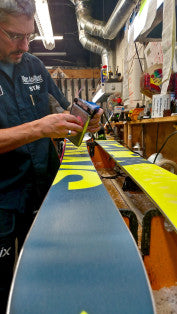 Next Adventure Ski Tech greg Coulter applies wax to the base of skis during a full tuneZ: What are the differences and advantages/ disadvantages of the different types of waxing methods? (Hotboxing, hot iron, machine, rub on)
G: Waxing is about getting wax into the base, not on the base. Rub on wax and machine buff waxes put wax on the base. This will usually last half a day at best. An iron wax is just as it sounds. You drip wax on to the base and iron it in like ironing a shirt. Just keep the iron moving or bad things will happen. Hotbox Waxing takes an iron-waxed ski and puts it into a hot box. This bakes the wax into the bases and helps to saturate the bases with wax.
Z: Does it really matter what kind and temperature wax we use? What’s the best for the conditions in the Pacific Northwest?
G: I believe it does make a difference. I am very fond of a cooler temp range wax, somewhere in the 18°F-28°F range. In the good old PNW we don't get super cold so this range works well. I actually run it in the summer as well because the snow is altered by salt and dirt and a colder wax is harder, offering a bit more wear protection.
Next Adventure Ski Tech greg Coulter applies wax to the base of skis during a full tuneZ: What are the differences and advantages/ disadvantages of the different types of waxing methods? (Hotboxing, hot iron, machine, rub on)
G: Waxing is about getting wax into the base, not on the base. Rub on wax and machine buff waxes put wax on the base. This will usually last half a day at best. An iron wax is just as it sounds. You drip wax on to the base and iron it in like ironing a shirt. Just keep the iron moving or bad things will happen. Hotbox Waxing takes an iron-waxed ski and puts it into a hot box. This bakes the wax into the bases and helps to saturate the bases with wax.
Z: Does it really matter what kind and temperature wax we use? What’s the best for the conditions in the Pacific Northwest?
G: I believe it does make a difference. I am very fond of a cooler temp range wax, somewhere in the 18°F-28°F range. In the good old PNW we don't get super cold so this range works well. I actually run it in the summer as well because the snow is altered by salt and dirt and a colder wax is harder, offering a bit more wear protection.
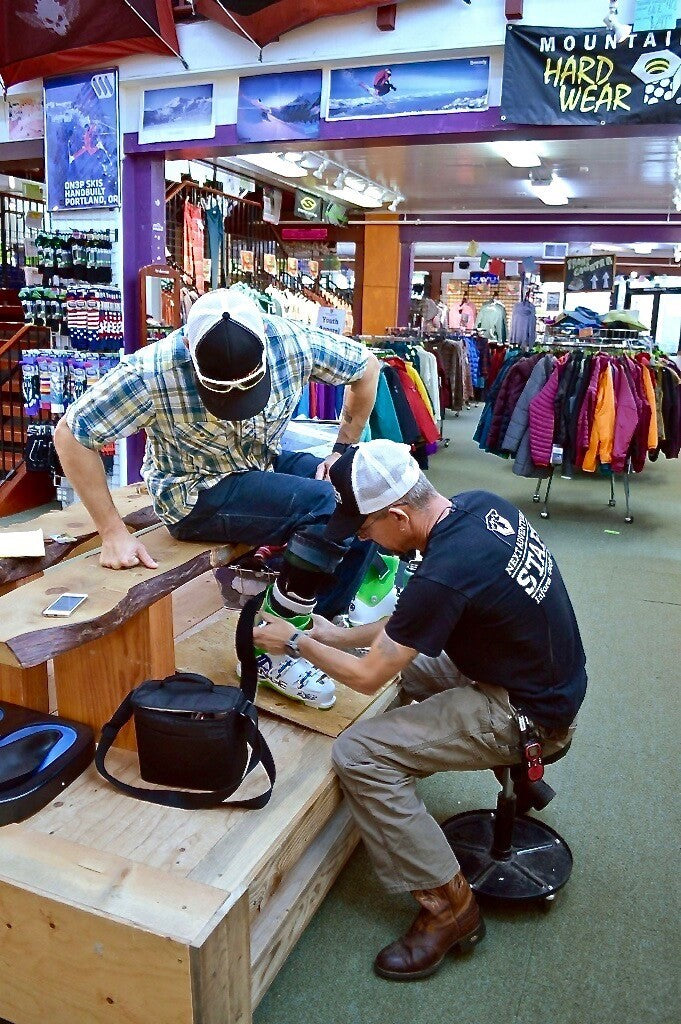 Greg ensures that the custom molded footbeds and boot liners give a comfortable, precise fit.
Z: You are a professional boot fitter, what is the best advice you could give to someone buying a new set of boots?
G: My advice is become informed and shop for a good fitter. Sales people are just that, they sell. I'm a fitter that sells boots, not a salesman that fits boots. Don't get caught up by the numbers, especially flex. Meaning those numbers are a SWAG as to the actual flex of the boot. There is NO industry standard for flex.
Z: Are custom moldable liners and footbeds really that important?
G: Yes they are, but they come at a price. Some boots come stock with a custom moldable liner, but a good aftermarket custom liner will work wonders. Remember however, they will not fix a poorly fitted shell. Insoles are the foundation of a properly fit boot. They support the foot while still allowing the foot and ankle to do their respective jobs.
Greg ensures that the custom molded footbeds and boot liners give a comfortable, precise fit.
Z: You are a professional boot fitter, what is the best advice you could give to someone buying a new set of boots?
G: My advice is become informed and shop for a good fitter. Sales people are just that, they sell. I'm a fitter that sells boots, not a salesman that fits boots. Don't get caught up by the numbers, especially flex. Meaning those numbers are a SWAG as to the actual flex of the boot. There is NO industry standard for flex.
Z: Are custom moldable liners and footbeds really that important?
G: Yes they are, but they come at a price. Some boots come stock with a custom moldable liner, but a good aftermarket custom liner will work wonders. Remember however, they will not fix a poorly fitted shell. Insoles are the foundation of a properly fit boot. They support the foot while still allowing the foot and ankle to do their respective jobs.
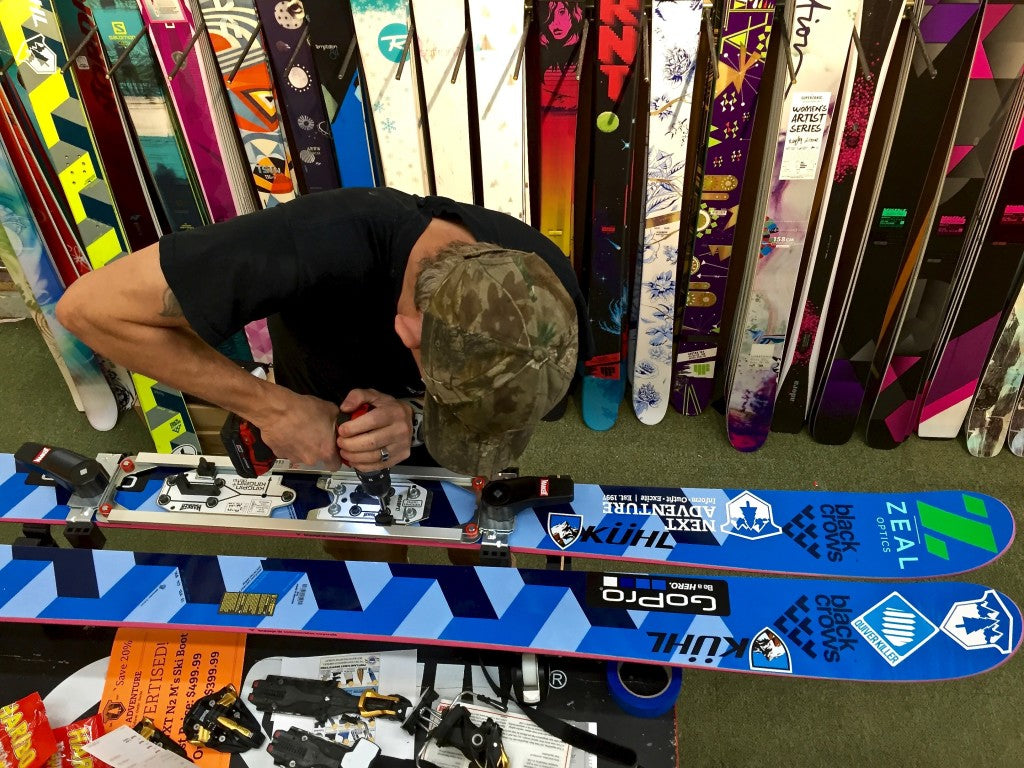 Greg uses a binding jig and drill to properly drill holes that will be used to mount the bindings to the skis
Z: We just spent a good bit of time getting these boots and footbeds properly fitted and now we are about to mount bindings on a new set of skis, what’s it take to set up bindings on a set of skis or snowboard? (stance, forward, back, DIN, etc)
G: Mounting bindings is not rocket surgery, but unless you want to buy a pair of skis for a person you just met, pay attention. The position of the binding is really up to the skier or rider. If they are not sure, I put them at the recommended mark. Most skis and boards offer multiple options. In general, centered or forward for freestyle and front side, a little back for powder and freeride. As far as the DIN setting goes, each company has a chart that the technicians use based on the information the customer gives us. We cannot tell a customer what type of skier they are. They have to put all the information on the form. If a spot is left blank, I will not mount the skis.
Greg uses a binding jig and drill to properly drill holes that will be used to mount the bindings to the skis
Z: We just spent a good bit of time getting these boots and footbeds properly fitted and now we are about to mount bindings on a new set of skis, what’s it take to set up bindings on a set of skis or snowboard? (stance, forward, back, DIN, etc)
G: Mounting bindings is not rocket surgery, but unless you want to buy a pair of skis for a person you just met, pay attention. The position of the binding is really up to the skier or rider. If they are not sure, I put them at the recommended mark. Most skis and boards offer multiple options. In general, centered or forward for freestyle and front side, a little back for powder and freeride. As far as the DIN setting goes, each company has a chart that the technicians use based on the information the customer gives us. We cannot tell a customer what type of skier they are. They have to put all the information on the form. If a spot is left blank, I will not mount the skis.
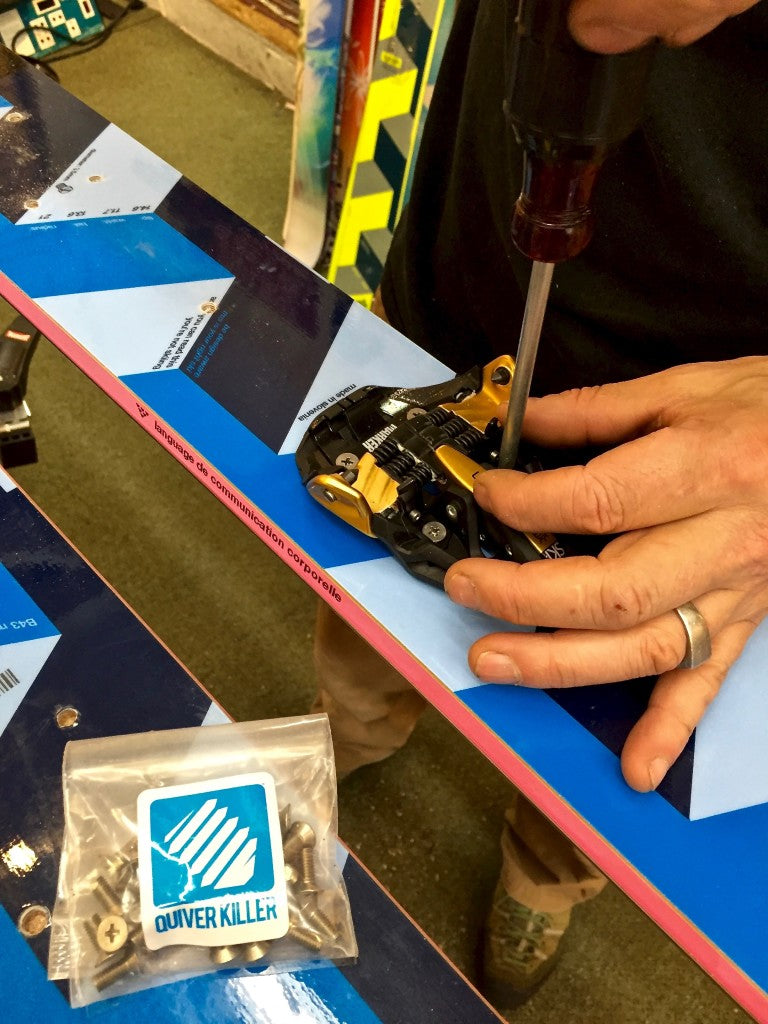 Greg places Quiver Killer binding inserts into Zach's skis. These allow for a single set of bindings to be mounted and removed between multiple sets of skis. Similar to snowboard inserts.
Z: Once everything is mounted, is there any maintenance involved in bindings and boots?
G: For boots, the best thing is to dry them out and don't use heat unless you want a Petrie dish and smelly boot. Always keep them buckled to maintain the correct wrap of the shell and try to limit walking on cement with them. For skis, hose them down, dry them off and wax them up for next time. At the end of the season, I recommend having a tune done and a storage wax put on. A storage wax is a thicker coat of wax that does not get scraped off. I recommend turning your bindings down all the way to prevent spring memory. End of season tunes are a great time to do this.
Greg places Quiver Killer binding inserts into Zach's skis. These allow for a single set of bindings to be mounted and removed between multiple sets of skis. Similar to snowboard inserts.
Z: Once everything is mounted, is there any maintenance involved in bindings and boots?
G: For boots, the best thing is to dry them out and don't use heat unless you want a Petrie dish and smelly boot. Always keep them buckled to maintain the correct wrap of the shell and try to limit walking on cement with them. For skis, hose them down, dry them off and wax them up for next time. At the end of the season, I recommend having a tune done and a storage wax put on. A storage wax is a thicker coat of wax that does not get scraped off. I recommend turning your bindings down all the way to prevent spring memory. End of season tunes are a great time to do this.
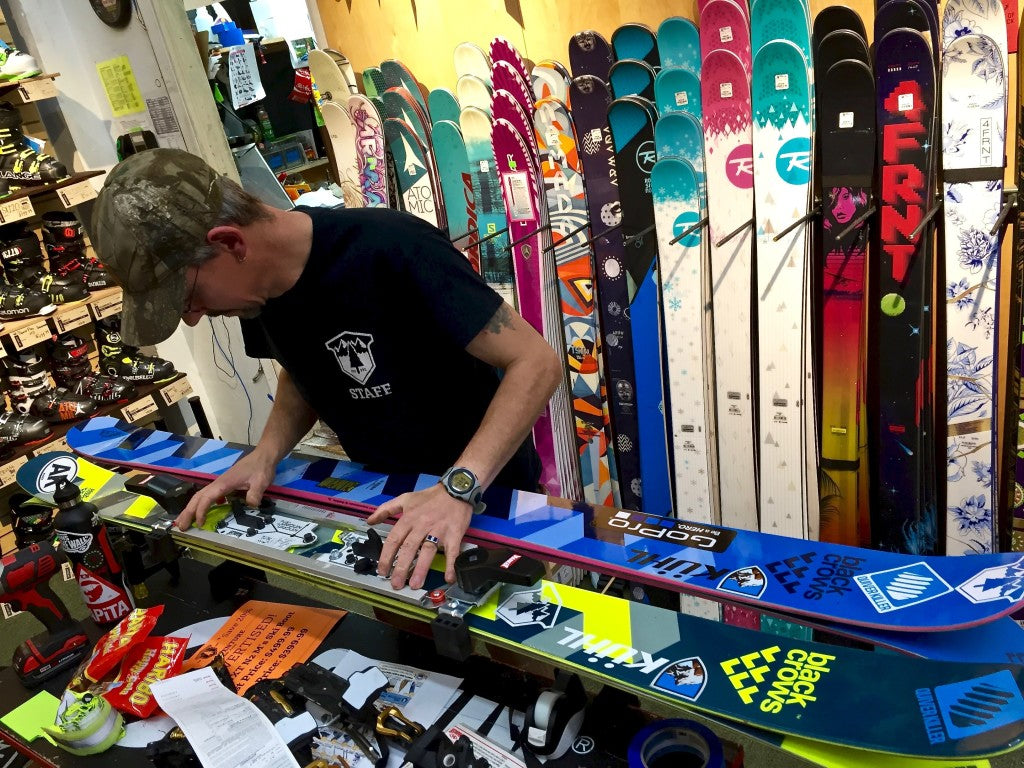 Z: In the opinion of a salty pro like yourself, is there any one (or two) things that are critical or “must do’s” for ski and snowboard maintenance leading up to and through the season?
G: If your feet hurt, you’re doing it wrong. Get your boots fit. Get your skis waxed, and don't wait until 5:30pm on a Friday night to take them to the shop to have it done for the next day. If you have never pulled file on skis or boards before, try it on a pair from goodwill before you decide to "tune" your own stuff. It will cost far less if you take it to a professional. Remember, damage never happens by 'Just Skiing Along', and shop guys don't work for free.
Z: In the opinion of a salty pro like yourself, is there any one (or two) things that are critical or “must do’s” for ski and snowboard maintenance leading up to and through the season?
G: If your feet hurt, you’re doing it wrong. Get your boots fit. Get your skis waxed, and don't wait until 5:30pm on a Friday night to take them to the shop to have it done for the next day. If you have never pulled file on skis or boards before, try it on a pair from goodwill before you decide to "tune" your own stuff. It will cost far less if you take it to a professional. Remember, damage never happens by 'Just Skiing Along', and shop guys don't work for free.
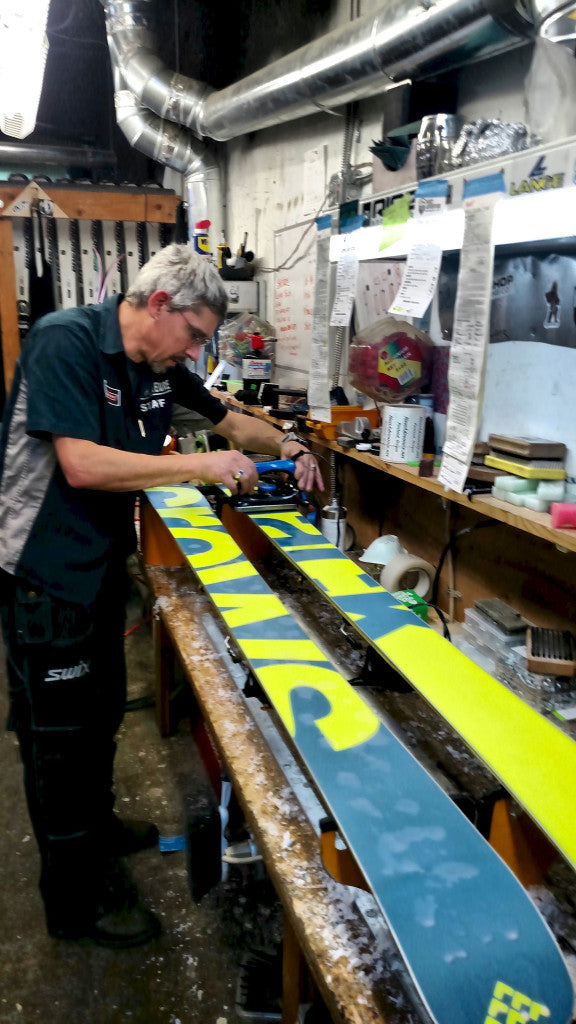 Greg Helps the base of the skis soak up the wax with a hot iron.At the end of the day, taking care of your gear will help take care of you, and your wallet. Properly fitted boots and tuned skis and boards will that super stoked feeling, big smiles, high fives from your friends and those super sick face shots you’ve been waiting all summer for… Well, at least the first three. Be sure to see Greg and the rest of the Next Adventure crew before your next ski outing or any other adventure you have on your itinerary. Stay tuned for more gear and tuning advice throughout the year. I hope to see you on your Next Adventure!!!
Greg Helps the base of the skis soak up the wax with a hot iron.At the end of the day, taking care of your gear will help take care of you, and your wallet. Properly fitted boots and tuned skis and boards will that super stoked feeling, big smiles, high fives from your friends and those super sick face shots you’ve been waiting all summer for… Well, at least the first three. Be sure to see Greg and the rest of the Next Adventure crew before your next ski outing or any other adventure you have on your itinerary. Stay tuned for more gear and tuning advice throughout the year. I hope to see you on your Next Adventure!!!
 Psyched about the finished product! Time to head to the mountain on their Next Adventure.
Psyched about the finished product! Time to head to the mountain on their Next Adventure.



 Greg ensures that the custom molded footbeds and boot liners give a comfortable, precise fit.
Greg ensures that the custom molded footbeds and boot liners give a comfortable, precise fit.
 Greg uses a binding jig and drill to properly drill holes that will be used to mount the bindings to the skis
Greg uses a binding jig and drill to properly drill holes that will be used to mount the bindings to the skis
 Greg places Quiver Killer binding inserts into Zach's skis. These allow for a single set of bindings to be mounted and removed between multiple sets of skis. Similar to snowboard inserts.
Greg places Quiver Killer binding inserts into Zach's skis. These allow for a single set of bindings to be mounted and removed between multiple sets of skis. Similar to snowboard inserts.


 Psyched about the finished product! Time to head to the mountain on their Next Adventure.
Psyched about the finished product! Time to head to the mountain on their Next Adventure.
